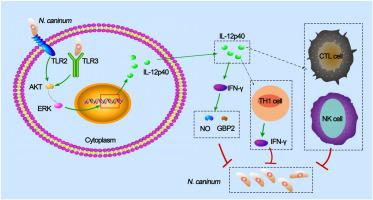Molecular Immunology ( IF 3.6 ) Pub Date : 2021-09-09 , DOI: 10.1016/j.molimm.2021.08.019 Xu Zhang 1 , Xin Li 1 , Pengtao Gong 1 , Xiaocen Wang 1 , Nan Zhang 1 , Mengge Chen 1 , Xichen Zhang 1 , Jianhua Li 1

|
Neospora caninum is an intracellular parasite which can cause neosporosis and significant economic losses in both dairy and beef industries worldwide. A better understanding of the immune response by host cells against N. caninum could help to design better strategies for the prevention and treatment of neosporosis. Although previous studies have shown TLR2/TLR3 were involved in controlling N. caninum infection in mice, the precise mechanisms of the AKT and MAPK pathways controlled by TLR2/TLR3 to regulate N. caninum-induced IL-12p40 production and the role of TLR2/TLR3 in anti-N. caninum infection in bovine macrophages remain unclear. In the present study, TLR2−/− mice displayed more parasite burden and lower level of IL-12p40 production compared to TLR3−/− mice. N. caninum could activate AKT and ERK signaling pathways in WT mouse macrophages, which were inhibited in TLR2−/− and TLR3−/− mouse macrophages. In N. caninum-infected WT mouse macrophages, AKT inhibitor or AKT siRNA could decrease the phosphorylation of ERK. AKT or ERK inhibitors reduced the production of IL-12p40 and increased the number of parasites. The productions of ROS, NO, and GBP2 were significantly reduced in TLR2−/− and TLR3−/− mouse macrophages. Supplementation of rIL-12p40 inhibited N. caninum proliferation and rescued the productions of IFN-γ, NO, and GBP2 in WT, TLR2−/−, and TLR3−/− mouse macrophages. In bovine macrophages, the expressions of TLR2, TLR3, and IL-12p40 mRNA were significantly enhanced by N. caninum, and N. caninum proliferation was inhibited by TLR2/TLR3 agonists. Taken together, the proliferation of N. caninum in mouse macrophages was controlled by the TLR2/TLR3-AKT-ERK signal pathway via increased IL-12p40 production, which in turn lead to the productions of NO, GBP2, and IFN-γ during N. caninum infection. And in bovine macrophages, TLR2 and TLR3 contributed to inhibiting N. caninum proliferation via increased IL-12p40 production.
中文翻译:

宿主通过 TLR2/TLR3-AKT-ERK 信号通路在 C57BL/6 小鼠中产生 IL-12p40 来防御犬新孢子虫感染
犬新孢子虫是一种细胞内寄生虫,可导致全球乳制品和牛肉行业的新孢子虫病和重大经济损失。更好地了解宿主细胞针对犬新孢子虫的免疫反应有助于设计更好的策略来预防和治疗新孢子虫病。尽管之前的研究表明 TLR2/TLR3 参与控制小鼠N. caninum感染,但 TLR2/TLR3 控制的 AKT 和 MAPK 通路调节N. caninum诱导的 IL-12p40 产生的确切机制和 TLR2/ TLR3 在牛巨噬细胞中抗犬新孢子虫感染中的作用尚不清楚。在本研究中,TLR2 -/-与 TLR3 -/-小鼠相比,小鼠表现出更多的寄生虫负担和更低的 IL-12p40 产生水平。N. caninum可以激活 WT 小鼠巨噬细胞中的 AKT 和 ERK 信号通路,这在 TLR2 -/-和 TLR3 -/-小鼠巨噬细胞中被抑制。在N. caninum感染的 WT 小鼠巨噬细胞中,AKT 抑制剂或 AKT siRNA 可以降低 ERK 的磷酸化。AKT 或 ERK 抑制剂减少了 IL-12p40 的产生并增加了寄生虫的数量。在 TLR2 -/-和 TLR3 -/-小鼠巨噬细胞中,ROS、NO 和 GBP2 的产生显着减少。补充 rIL-12p40 抑制犬新孢子虫增殖并挽救了 WT、TLR2 -/-和 TLR3 -/-小鼠巨噬细胞中 IFN-γ、NO 和 GBP2 的产生。在牛巨噬细胞中,TLR2、TLR3 和 IL-12p40 mRNA 的表达被N. caninum显着增强,并且N. caninum增殖被 TLR2/TLR3 激动剂抑制。总之,小鼠巨噬细胞中犬新孢子菌的增殖受 TLR2/TLR3-AKT-ERK 信号通路的控制,通过增加 IL-12p40 的产生,进而导致在N期间产生 NO、GBP2 和 IFN-γ。. 犬感染。在牛巨噬细胞中,TLR2 和 TLR3 有助于抑制N. caninum 通过增加 IL-12p40 产生促进增殖。


























 京公网安备 11010802027423号
京公网安备 11010802027423号